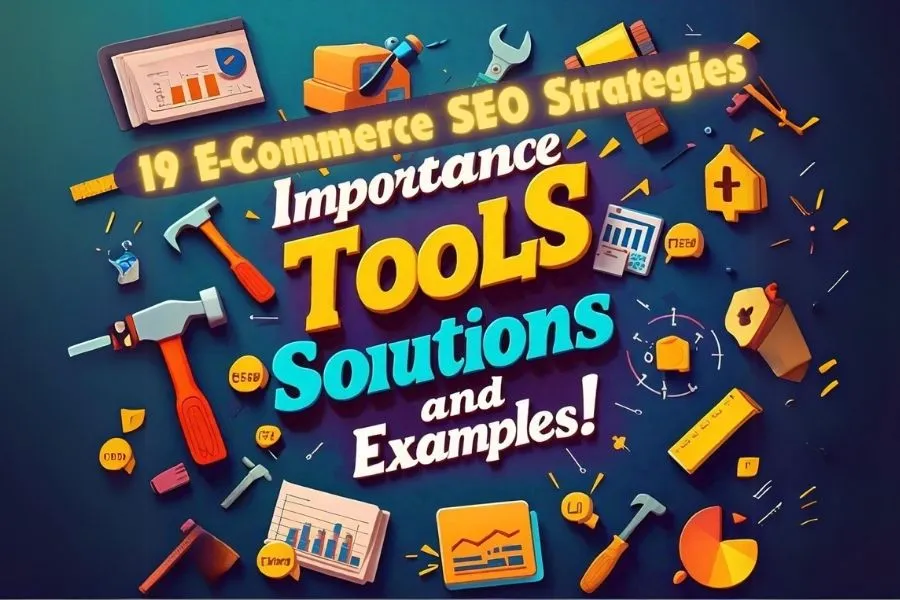Table of Contents
Introduction
E-commerce SEO is like the secret sauce that makes your online store visible to the world. In 2024, staying ahead of the competition means having a rock-solid SEO strategy. Let’s dive into 19 effective strategies that is Improve page load time, Perform keyword research, Add schema markup, Improve urls, Optimize product pages, Optimize your code, Find effective keywords, Improve internal linking, Improve site architecture, Start backlinking, Add a sitemap, Avoid duplicate content, Create helpful content, Use alt text for your images, Use responsive design, Write thoughtful product descriptions, Focus on homepage seo, Optimize your title tags, Link building for ecommerce, and Optimize your meta descriptions will help your e-commerce site shine in search results.
19 E-Commerce SEO Strategies

1. Improve Page Load Time
Why it matters: A fast-loading site is crucial for user experience and SEO. Slow pages cause higher bounce rates and decrease rankings.
Tools to check load time: Use tools like Google PageSpeed Insights and GTmetrix.
Steps to improve: Compress images, use browser caching, and minimize CSS, JavaScript, and HTML.
Example: Amazon consistently improves its page load time to ensure users have a seamless shopping experience, which helps maintain its high search rankings.
2. Perform Keyword Research
Importance of keyword research: Finding the right keywords helps you target what your customers are searching for.
Tools to use: Ahrefs, SEMrush, and Google Keyword Planner,.
How to find effective keywords: Look for long-tail keywords with high search volume and low competition.
Example: An online shoe store might use “best running shoes for women” instead of just “shoes” to attract more specific and interested buyers.
3. Add Schema Markup
What is schema markup? Markup code helps search engines to understand your website content.
Benefits of schema markup: Enhances your listings with rich snippets, improving click-through rates.
How to implement it: Use tools like Schema.org or plugins like Yoast SEO.
Example: Best Buy uses schema markup to display product ratings and availability directly in search results, which attracts more clicks.
3. Improve URLs
Importance of clean URLs: User-friendly URLs improve click-through rates and SEO.
Tips for optimizing URLs: Keep them short, include keywords, and avoid special characters.
Example: A URL like www.mystore.com/product/12345 should be changed to www.mystore.com/blue-running-shoes for better SEO.
4. Optimize Product Pages
Key elements to focus on: Title tags, meta descriptions, headers, and images.
Best practices for optimization: Use high-quality images, detailed product descriptions, and customer reviews.
Example: Nike ensures its product pages are optimized with engaging descriptions and professional photos to enhance user experience and SEO.
5. Optimize Your Code
Why clean code is important: Improves site speed and makes it easier for search engines to crawl your site.
How to optimize code for SEO: Minify CSS, JavaScript, and HTML, and remove unnecessary code.
Example: Shopify offers built-in features and apps to help e-commerce sites clean up their code for better performance and SEO.
6. Find Effective Keywords
Strategies for keyword research: Focus on long-tail keywords relevant to your products.
Long-tail keywords vs. short-tail keywords: Long-tail keywords are more specific and often have higher conversion rates.
Example: Instead of “laptop,” use “best laptop for graphic design” to target a more specific audience.
7. Improve Internal Linking
Benefits of internal linking: Helps search engines understand your site structure and improves navigation.
How to implement an effective strategy: Link to related products and use descriptive anchor text.
Example: An online bookstore might link from a book’s page to related books or genres to keep users engaged and improve SEO.
8. Improve Site Architecture
Importance of good site structure: A well-structured site is easier for search engines to crawl and index.
Tips for improving site architecture: Use a clear hierarchy, create categories, and keep navigation simple.
Example: IKEA has a clean, intuitive site structure that helps users and search engines find what they need quickly.
9. Start Backlinking
Why backlinks matter: They are like votes of confidence from other sites, boosting your authority and rankings.
Strategies for acquiring backlinks: Guest blogging, partnerships, and creating shareable content.
Example: A fashion retailer might collaborate with fashion bloggers to get featured on their sites, earning valuable backlinks.
10. Add a Sitemap
What is a sitemap? A file that lists all your site’s pages, helping search engines crawl your site more effectively.
How to create and submit a sitemap: Use tools like XML Sitemaps or plugins like Yoast SEO, and submit it through Google Search Console.
Example: Submitting a sitemap ensures that all pages of an online electronics store are indexed by Google, improving overall SEO.
11. Avoid Duplicate Content
The dangers of duplicate content: It confuses search engines and can lead to lower rankings.
How to identify and fix duplicate content issues: Use tools like Copyscape and consolidate similar pages.
Example: An online clothing store might have multiple pages for similar products, which should be consolidated to avoid duplication.
12. Create Helpful Content
Importance of valuable content: Engaging, informative content keeps visitors on your site longer and encourages sharing.
Tips for creating engaging content: Focus on your audience’s needs, use visuals, and update regularly.
Example: A kitchenware store might create blog posts with cooking tips and recipes that feature their products, providing value to customers and improving SEO.
13. Use Alt Text for Your Images
Why alt text is important: It helps search engines understand your images and improves accessibility.
How to write effective alt text: Describe the image clearly and include relevant keywords.
Example: An online art gallery uses alt text like “modern abstract painting in blue and gold” to describe their images, which helps with SEO.
14. Use Responsive Design
Benefits of responsive design: Ensures your site looks great on all devices, improving user experience and SEO.
How to implement responsive design: Use responsive themes and test your site on multiple devices.
Example: Zappos uses responsive design to ensure their site is user-friendly on smartphones, tablets, and desktops.
15. Write Thoughtful Product Descriptions
Importance of detailed descriptions: Helps customers understand your products and improves SEO.
Tips for writing effective product descriptions: Be descriptive, use keywords naturally, and highlight key features.
Example: ASOS provides detailed, engaging product descriptions that help customers make informed decisions and improve SEO.
16. Focus on Homepage SEO
Key elements to optimize on your homepage: Title tag, meta description, headers, and main content.
Best practices: Include keywords, provide clear navigation, and ensure fast loading times.
Example: The homepage of Walmart is optimized with clear headers, concise meta descriptions, and fast loading times to enhance SEO.
17. Optimize Your Title Tags
Importance of title tags: They are the first thing users see in search results and impact click-through rates.
Tips for writing effective title tags: Keep them under 60 characters, include keywords, and make them compelling.
Example: A title tag like “Affordable Running Shoes – Free Shipping | Store Name” is clear and optimized for SEO.
18. Link Building for E-Commerce

Importance of link building: Builds your site’s authority and improves search rankings.
Strategies for effective link building: Reach out to influencers, create shareable content, and participate in industry forums.
Example: An online pet store might collaborate with pet bloggers to feature their products and earn valuable backlinks.
19. Optimize Your Meta Descriptions
What are meta descriptions? Short description of your pages that appear in search results.
Tips for writing compelling meta descriptions: Keep them under 160 characters, include keywords, and make them enticing.
Example: A meta description like “Shop the latest trends in women’s fashion. Free shipping on orders over $50. Discover your style today!” is engaging and optimized for SEO.
Conclusion
Mastering e-commerce SEO in 2024 is all about implementing a combination of these effective strategies. From improving page load time to optimizing your meta descriptions, every step you take brings you closer to dominating the search results and attracting more customers.
FAQs
1. What is the most important aspect of e-commerce SEO?
Improving page load time is crucial as it impacts both user experience and SEO rankings.
2. How often should I perform keyword research?
Regularly, at least every few months, to stay updated with changing trends and search behaviors.
3. Can I use the same keywords for all my product pages?
It’s better to use specific keywords tailored to each product to avoid keyword cannibalization and improve relevance.
4. How do I know if my site architecture is effective?
Use tools like Google Analytics to track user behavior and look for any issues in navigation or high exit rates.
5. Why is responsive design important for SEO?
It ensures your site is accessible and user-friendly across all devices, which is a key factor in search engine rankings.

